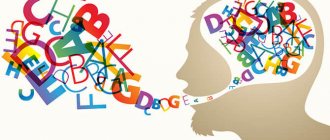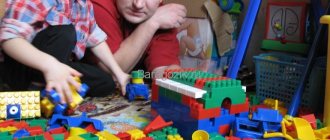Aphasia is a systemic speech disorder that occurs with organic lesions of the brain, covers different levels of speech organization, affects its connections with other mental processes and leads to disintegration of the entire mental sphere of a person.
Aphasia includes four components - a violation of speech itself and verbal communication, a violation of other mental processes associated with speech, a change in personality and personal reaction to the disease.
The causes of aphasia are cerebral circulation disorders (ischemia, hemorrhage), trauma, tumors, and infectious diseases of the brain. Aphasia of vascular origin most often occurs in adults. As a result of rupture of cerebral aneurysms, thromboembolism caused by rheumatic heart disease, and traumatic brain injuries, aphasia is often observed in adolescents and young adults.
The complexity of the speech disorder in aphasia depends on the location of the lesion. A.R. Luria distinguishes six forms of aphasia:
- acoustic-gnostic and acoustic-mnestic aphasia, which occurs when the temporal parts of the cerebral cortex are damaged,
- semantic aphasia and afferent motor aphasia, arising from damage to the lower parietal parts of the cerebral cortex,
- efferent motor aphasia and dynamic aphasia, which occur with damage to the premotor and posterior frontal parts of the cerebral cortex (on the left in right-handed people).
When speech zones are damaged, there is a violation of the so-called primary prerequisite that carries out the specific activity of the corresponding analyzer system. Based on the primary analytical disturbance, a secondary, also specific, collapse of the entire functional system of language and speech occurs, i.e. There is a violation of all types of speech activity: understanding speech, oral and written speech, counting, etc.
Peculiarities
Motor aphasia is brain damage in Broca's area, which is characterized by irreversible organic changes in brain tissue with a complete loss of its functional activity in this area. Experts distinguish two main clinically significant forms of motor aphasia: afferent and efferent motor aphasia. With this disease, there is a disruption of the synthetic activity of the brain with loss of speech function, together with its perception. In this case, the patient has no situational speech, i.e. the patient cannot maintain a dialogue because he simply does not perceive it.
Afferent motor aphasia
Afferent or kinesthetic aphasia is manifested by difficulty in reproducing speech, mainly due to problems in the articulatory apparatus. Thus, patients with afferent motor aphasia cannot and cannot connect their own speech into a complete structured sentence.
Patients often try to replace words that they cannot pronounce with synonyms, which leads to a significant slowdown in spoken speech. The difficulty in pronouncing consonant sounds also attracts attention.
In most cases, afferent motor aphasia is combined with agraphia, a writing disorder.
Efferent motor aphasia
It occurs as a result of damage to the premotor areas of the cerebral cortex. Efferent motor aphasia manifests itself by literally jamming the patient’s speech on specific sounds. The patient cannot change the position of the articulatory apparatus, which leads to large time pauses between pronounced sounds. Speech becomes telegraphic or stamped.
It is worth noting that in almost half of all cases of identified motor aphasia in patients, a combination of both afferent and efferent aphasia occurs. Mixed aphasia is manifested by a complex manifestation of all of the above manifestations, which is called the term sensorimotor speech disorder.
ACOUSTIC-GNOSTIC SENSORY APHASIA
This form of aphasia is characterized by impaired understanding of speech when perceiving it by ear. The basis of speech acoustic agnosia is a violation of phonemic hearing. Someone else's speech is perceived as an inarticulate stream of sounds. Inability to understand the speech of others and the absence of obvious motor disorders leads to the fact that patients do not always immediately realize that they have a speech disorder associated with a stroke or injury.
With sensory aphasia, the root lexical-semantic part of a word is difficult to catch by ear, resulting in a loss of its subject relevance. However, the categorical attribution of a word can be “perceived.” For example, hearing the word bell, the patient says: “It’s something small, but I don’t know what.” In patients with acoustic-gnostic sensory aphasia, auditory control of their speech is disrupted. Because of this, many literary and verbal paraphasias arise.
The patient’s early speech may be completely incomprehensible to others; it consists of random sets of sounds, syllables, and phrases, which is called “jargonophasis” or “speech hash.”
Due to a violation of phonemic perception, the repetition of words suffers a second time, and the rhythmic and melodic basis is lost. The period of jargonophasia lasts no more than 1.5 - 2 months, gradually giving way to logorrhea with pronounced agrammatism. In the study of the nominative function in sensory, acoustic-gnostic aphasia, along with correct naming, attempts are observed to explain the meaning of the word or find it through the phraseological context. For example, when naming an apple, it is said: “Well, of course, I know very well that it is a pear, not a pear, a sour apple,” etc.
When reading, many literary paraphasias appear, difficulty arises in finding the place of stress in a word, which makes reading comprehension more difficult. But reading remains the most preserved speech function in sensory aphasia.
Written speech is impaired to a greater extent and is directly dependent on the state of phonemic hearing. Severe counting disorders in sensory acoustic-gnostic aphasia are observed only at a very early stage.
Causes of afferent motor aphasia
The causes of the formation of motor afferent aphasia are a number of diseases that lead to organic damage to the cerebral cortex, including Broca’s area, as well as the premotor cortex. Most often, afferent aphasia is caused by diseases with extensive damage to brain structures, for example:
- Acute cerebrovascular accident or stroke. Moreover, a stroke is hemorrhagic in nature, in which massive hemorrhage occurs in the structures of the brain. Blood soaking and compression of the posterior regions of the frontal zone leads to damage to Broca's center and the development of afferent motor aphasia;
- Infectious and inflammatory diseases of the brain. Most often these include encephalitis or leukoencephalitis. Inflammatory diseases lead to softening of brain tissue and the formation of abscess cavities;
- Traumatic brain injuries, especially with severe brain contusion and subarachnoid hemorrhage. Brain contusion and edema lead to compression of brain structures, which can also damage Broca’s center;
- Development of a tumor process localized in the frontal or temporal lobes on the side of the dominant hemisphere;
- Epilepsy, in the presence of an epileptogenic focus in close anatomical proximity to the speech center of the brain;
- Toxic damage to brain structures, for example, from heavy metals or other poisons.
A number of chronic diseases also contribute to the development of afferent motor aphasia:
- Chronic pathology of blood circulation, due to the presence of an aneurysm or atherosclerotic changes in the vascular wall of the cerebral arteries.
- Slowly progressive diseases of the central nervous system: multiple sclerosis or encephalomyelitis. Demyelination of nerve fibers leads to disruption of afferent and efferent connections of the speech center with other structures of the brain;
- Formation of prion protein.
SEMANTIC APHASIA
Stage of disorders of moderate and mild severity
1. Overcoming spatial apractognosia:
— a schematic representation of the spatial relationships of objects;
- image of the plan of the path, room, etc.;
- design according to a model, according to a verbal task;
— work with a geographical map, hours.
2. Restoring the ability to understand words with spatial meaning (prepositions, adverbs, verbs with “movement” prefixes, etc.):
— a visual representation of simple spatial situations denoted by prepositions and other parts of speech;
— filling in missing “spatial” elements in words and phrases;
- composing phrases with words that have spatial
3. Construction of complex sentences:
— clarification of the meanings of subordinating conjunctions;
— filling in missing main and subordinate clauses;
- composing sentences with given conjunctions.
4. Restoring the ability to understand logical and grammatical situations:
- a picture depiction of the plot of the structure;
- the introduction of additional words that provide semantic redundancy (“my brother’s father”, “a letter from a beloved friend”, etc.);
— introduction of logical-grammatical constructions into a detailed semantic context;
- presenting designs in writing and then orally.
5. Work on an extended statement:
- presentations, essays;
— improvisation on a given topic;
- interpretation of words with complex semantic structure...
Article from the site: wapref.ru/referat_qasyfsujgpolyfsaty.html
Symptoms
Afferent aphasia is accompanied by the occurrence of a number of symptoms and syndromes, which form the clinical picture characteristic of this form. Expressive language impairment syndrome includes:
- Violation of spatial movements, such as facial expressions and gestures, as well as a complete absence of situational speech process. When trying to repeat sounds, the patient makes only isolated movements with his lips and tongue;
- Speech becomes overly clichéd, there are syllable and sound dropouts.
The patient also experiences pronounced difficulties in pronouncing complex syllables, namely: they divide words into parts and skip the most complex sounds. There is a violation of the understanding of someone else's speech, however, this period does not last long from a day to several days and occurs after suffering an acute cerebrovascular accident.
The victim’s spatial disorientation, as well as impairment of writing and perception of visual text information, are also noteworthy. When writing, the patient shifts vowels, omits consonants, and changes the order of letters.
DYNAMIC APHASAIA
Stage of severe disorders
1. Increasing the level of general activity of the patient, overcoming speech inactivity, organizing voluntary attention:
- performing various types of non-verbal activities (drawing, modeling, etc.);
— assessment of distorted images, words, phrases, etc.;
- situational, emotionally significant dialogue for the patient;
- listening to plot texts and answering questions about them in the form of affirmative-negative gestures or words “yes”, “no”.
2. Stimulating simple types of communicative speech:
— automation in dialogical speech of communicatively significant words: “yes”, “no”, “can”, “want”, “will”, “must”, etc.;
— automation of individual cliches of communicative, incentive and interrogative speech: “give”, “come here”, “who’s there?”, “hush!” etc.
3. Overcoming speech programming disorders:
- stimulation of answers to questions with a gradual decrease in the answer of words borrowed from the question;
- constructing phrases of the simplest syntactic models based on chips and a simple plot picture;
- performing simple grammatical transformations to change words that make up a phrase, but are presented in nominative forms;
- laying out a series of sequential pictures according to the plot contained in them.
4. Overcoming grammatical structuring disorders
5. Stimulating written speech:
— laying out captions under pictures;
- reading ideogram words and phrases.
Moderate stage of disorders
1. Restoration of communicative phrasal speech:
— construction of a simple phrase;
- composing phrases based on a plot picture using the chip method and gradually “collapsing” the number of external supports;
- compiling a story based on a series of sequential pictures;
— detailed answers to questions in the dialogue;
- compiling simple dialogues like speech sketches: “In a store” - a dialogue between a buyer and a seller, “In a savings bank”, “In an atelier”, etc.
2. Overcoming perseverations in independent oral and written statements:
- display of objects in pictures and in the room, parts of the body (in random order, by individual names and by series of names);
- ending phrases with different words;
- selection of words of given categories and in given quantities, for example, two words related to the topic “Clothing” and one word related to the topic “Tableware”, etc.;
- writing numbers and letters broken down (from dictation);
- writing from dictation of words and phrases that contribute to the development of semantic and motor switching;
— elements of sound-letter analysis of the composition of a word: folding simple words from letters of a split alphabet;
- filling in gaps in words;
- writing simple words from memory and dictation.
Stage of mild disorders
1. Restoration of spontaneous communicative phrasal speech:
- extensive dialogue on various topics;
- constructing phrases based on a plot picture with a gradual decrease in the number of external supports;
— automation of phrases of certain syntactic models in spontaneous speech;
- accumulation of a verbal dictionary and “revitalization” of the semantic connections behind the predicate (with the help of questions posed to it);
- reading and retelling texts;
- “role-playing conversations”, playing out a certain situation;
- “speech improvisations” on a given topic;
- detailed presentations of texts, essays;
- drafting greeting cards, letters, etc.
Diagnostics
The diagnostic search is aimed at identifying the underlying disease or cause that served as the impetus for the development of motor afferent aphasia. The diagnostic plan includes a standard set of studies. The first step is to collect an anamnesis of the disease, after which a topical diagnosis is carried out to determine the expected extent of damage to brain tissue, then a preliminary diagnosis is made.
To clarify it, a number of instrumental studies are carried out, such as:
- Magnetic resonance imaging of the brain, and contrast can also be used to improve brain imaging characteristics. Magnetic resonance imaging allows you to identify oncological lesions, the presence and volume of a hematoma in traumatic brain injury;
- Angiography of cerebral arteries for the presence or absence of vascular pathology;
- Ultrasound Doppler examination of neck vessels;
- Lumbar puncture if there is suspicion of encephalitis, meningitis or leukoencephalitis;
- Electroencephalography to exclude pathology of an epileptiform nature or oncological lesions of the brain.
The Clinical Brain Institute is focused on studying, diagnosing and treating patients with neurological symptoms, including patients with motor aphasia. The Clinical Institute of the Brain operates a powerful and modern diagnostic department, which makes it possible to make correct diagnoses with a high degree of probability.
Symptoms of dysphasia
Most symptoms of dysphasia are nonspecific and characteristic of many diagnoses associated with speech dysfunctions. Each specific case must be assessed in conjunction with clarification of the structure of the defect and the presence of several symptoms at once:
- late appearance of babbling and absence of onomatopoeia in the first and second years of life (“meow”, “bang”, “am”, “woof”);
- poor vocabulary after 2.5 years;
- absence of generalizing words, synonyms, antonyms in speech after 3 years;
- excessive silence (the child seems to understand everything, but simply does not want to speak);
- problems with full pronunciation of words and sentences in children over 5 years old (the child distorts words, pronounces only the first syllable);
- partial or complete misunderstanding of the speech of other people in children over 2 years old, lack of interest in it (the child may react incorrectly to some requests, not respond to his own name, during a conversation he carefully looks at the interlocutor’s mouth, as if trying to read on the lips)
- a child with dysphasia often uses facial expressions and gestures to communicate, replacing words with them;
- Dysphatic children are characterized by speech disorders such as echolalia (constant repetition of new, just heard words, which occurs automatically and cannot be controlled) and logorrhea (speech pathology, manifested in excessive verbosity, speech agitation).
Treatment
The main treatment should be aimed at eliminating the underlying cause that led to the formation of afferent motor aphasia. Depending on the underlying pathology, treatment tactics will differ significantly.
- In the presence of a tumor process, surgical intervention on the brain or a course of radiation and chemotherapy.
- In the presence of an infectious focus or abscess, drainage in combination with antibacterial therapy and the use of general stabilizing drugs.
- In case of acute cerebrovascular accident - a course of treatment with drugs with nootropic effects, antioxidants, angioprotectors. For hemorrhagic stroke with severe compression of the brain - surgical treatment.
- For epilepsy, the main therapy is aimed at the use of anticonvulsants.
- For demyelinating and degenerative processes in nervous tissue, glucocorticosteroids are used.
All of the above treatment regimens will be effective in the treatment of aphasia, as they have a pathogenetic mechanism for correcting the pathological manifestations of the disease.
Diagnosis of dysphasia
A child with any form of dysphasia needs to be examined by a psychologist, neuropsychologist, speech therapist and neurologist. It is necessary to seek help from specialists if the child’s speech develops with a pronounced lag behind the norm. However, there is no need to sound the alarm ahead of time; speech development is an individual process. It is recommended to diagnose dysphasia in children at least 2.5-3 years old. A neurological examination can determine the extent of brain damage. To make a correct diagnosis, specialists need to exclude pathologies with similar symptoms: delayed speech development, dysarthria, mutism, hearing loss, autism, childhood depression, mental retardation. The speech therapist assesses the state of speech, the volume of vocabulary, the state of the articulatory apparatus, and the level of understanding of addressed speech. A neuropsychologist identifies dysfunctional areas of the brain, participates in making a diagnosis and identifying associated disorders, planning correctional work; if necessary, in conducting classes with the child.
Rehabilitation
It is very important that the treatment is comprehensive and closely related to rehabilitation measures. The Clinical Institute of the Brain is one of the first centers in the country that began the combined use of therapeutic and rehabilitation measures. Rehabilitation consists of:
- Systematic visits to a speech therapist, at least three times a week;
- Dual mode operation, i.e. both with a specialist and independently.
Rehabilitation classes are aimed at restoring articulate speech; for this, patients sing songs and read poetry, since during these classes words are stretched into syllables and train the patient’s articulatory apparatus. Separately, it is worth mentioning the restoration of writing; for this, patients write letters under dictation.
For a more effective and quick recovery of the patient, it is necessary to involve close relatives and friends in treatment. The patient should not be allowed to remain and be in social isolation for a long time.
At the Clinical Institute of the Brain, there is a specialist aphysiologist who develops individual programs for each individual patient to restore speech and writing function in cases of severe cognitive disorders.
Adviсe
Aphasia is not a mental illness, even if there are severe speech impairments. It is worth treating the patient with understanding and patience. You should not raise your voice at the patient, as this will not improve the understanding of the information and the meaning of what is being said. You should speak to the patient as slowly as possible, without using complex structures in sentences. Gestures should also be limited. Use questions that can be answered with a clear yes or no.
To improve the perception of information by patients, try to exclude all extraneous noise. Try not to limit the patient’s communication and ask him more questions.
ACOUSTIC-MNESTIC APHASIA
Acoustic-mnestic aphasia occurs when the middle and posterior parts of the temporal region are damaged. It is believed that it is based on a decrease in auditory-verbal memory, which is caused by increased inhibition of auditory traces. Acoustic-mnestic aphasia is characterized by a dissociation between the relatively intact ability to repeat individual words and the impaired ability to repeat three or four unrelated words (for example: hand-house-sky, etc.)
In acoustic-mnestic aphasia, speech memory impairment is the main defect, because phonemic hearing and the articulatory side of speech are preserved. Increased speech activity compensates for communication difficulties. The auditory verbal memory of these patients is characterized by great inertia.
Violation of the volume of retention of speech information, its inhibition leads to difficulties in understanding in this form of aphasia long, polysyllabic statements consisting of five to seven words. Patients find it difficult to navigate a conversation with two or three interlocutors, “switch off” in a difficult speech situation, cannot attend reports, lectures, and get tired when listening to music and radio broadcasts. This fact should be taken into account when prescribing such treatment methods as “art therapy”, etc.
With optical aphasia, the second variant of acoustic-mnestic aphasia, difficulties arise in retaining the semantic aspect of speech by ear; they consist in weakening and impoverishment of visual representations of an object, in the relationship between what is perceived by ear and its visual representation. The visual representation of an object becomes incomplete; those elements of objects that, on the one hand, are specific to them, and on the other hand, are associated with the polysemy of the word (for example, the words spout, comb, pen) are not completed.
Patients understand the meaning of individual words. They do not have articulatory difficulties, they are not only verbose, but also hyperactive. However, with all this, they only partially understand speech due to the narrowing of auditory-verbal memory to 1-2 out of 3 words perceived by ear. Speech is abundant, little informative, replete with verbal paraphasias, but intonation-colored.
In written speech with acoustic-mnestic aphasia, the phenomena of expressive agrammatism appear more prominently, i.e. displacement of prepositions, as well as inflections of verbs, nouns and pronouns, mainly in gender and number. The nominative side of written speech turns out to be more preserved. When recording text from dictation, patients experience significant difficulties in retaining even a phrase in their auditory-verbal memory. Consisting of three words, they are asked to repeat each fragment of the phrase.
With acoustic-mnestic aphasia, it is difficult to perceive printed text when reading. This is due to impaired preservation of auditory-verbal memory.
Prevention of afferent and efferent motor aphasia
There is no specific prevention for the development of aphasia. All preventive measures are primarily aimed at eliminating risk factors that increase the risk of vascular diseases. Since acute cerebrovascular accident is the most common cause of aphasia, stroke prevention has an indirect effect on the development of aphasia.
Timely treatment of arterial hypertension, correction of the blood lipid profile, as well as annual preventive examinations will help to avoid extensive brain damage.
As with any other disease, prevention implies:
- Maintaining a healthy lifestyle;
- Proper nutrition;
- Normalization of the work-rest regime;
- Rejection of bad habits.
What it is
Broca's aphasia is a neurological syndrome characterized by a complex disorder of formed speech. Most often it is accompanied by three pathologies: agrammatism, anomia and disarticulation. However, the syndrome may also include other disorders, such as motor dysprosody or reading and writing impairment. Afferent motor aphasia is included in the syndrome of damage to the frontal areas of the cerebral cortex.
All these disorders have one root - the pathology of the formation of one’s own speech, while maintaining the sensory component, that is, the patient understands words and their meaning, but cannot say something of his own. Although there are mixed disorders that combine impaired understanding and speech formation.
Speech pathology is considered not only a neurological, but also a mental and social disorder. With dysphasia, a critical attitude towards one's illness is maintained, in contrast to sensory aphasia. A patient with motor aphasia is aware of his disability.
Psychasthenic individuals or people with depressive accentuation can close themselves off from society and have a hard time experiencing the disorder. Social adaptation and intellectual potential are reduced. Such people do not want to come into contact with others and do not leave the house. Mild isolation can reach extreme reclusiveness.
Motor dysphasia limits vitality. The degree of impairment of a person's functions is determined by clinical and functional severity.
Grade 1 – mild motor dysphasia. Oral conversation is impaired, vocabulary decreases. A disability group is not issued.
2nd degree – moderate dysphasia. Oral speech is limited, vocabulary is reduced, and the conversation consists of simple template phrases. Disability group 3 is issued.
3rd degree – severe speech pathologies. Interaction with others is severely limited. Facial expressions and gestures are used for clear communication. Disability group 2 is issued.
4th degree – total dysphasia. A disability group of 1 is issued, since the patient cannot interact with society due to a lack of understanding of oral speech and the inability to formulate a sentence or somehow convey information.
Motor cortical aphasia (Braque's aphasia)
Motor aphasia occurs with lesions of the lower parts of the left frontal lobe and is characterized by slow, laconic, poorly articulated speech. requiring a lot of effort from the patient (it is difficult to merge words or even sounds). In severe cases, the patient utters only inarticulate sounds.
The patient's speech is difficult, with impaired articulation, and is often interrupted by pauses to search for words. Phrases contain almost no function words and consist mainly of verbs and nouns. The word order is disrupted, edge morphemes (word endings that express the tense and mood of verbs, case, gender and number of nouns) are used incorrectly. Telegraphic speech is typical - concise, but quite informative. For example, a 45-year-old man with motor cortical aphasia talks about his illness like this: “I went. doctor. The doctor sent me. Bosson. Hospital. Doctor. There. Two, three days. The doctor sent me home."
The patient’s speech may be limited to a hum or a single word (“yes” or “no”), which he pronounces with different intonations, trying to express his attitude to what is happening. Naming and repetition are impaired. Understanding of oral speech is preserved - with the exception of complex sentences and passive voice constructions. Reading is preserved, but characteristic hesitations are noticeable when reading short function words.
Consequently, motor cortical aphasia is not only an “expressive”, “motor” disorder, but also a disorder of understanding—in this case, of function words and syntactic constructions.
Patients are tearful, easily fall into despair and deep depression.
Unlike patients with sensory cortical aphasia, they understand their condition. In such patients, even deeply disturbed articulation becomes almost normal when singing - one of the methods of speech restoration (melody-intonation therapy) is based on this feature.
Associated neurological symptoms: right-sided facial muscle weakness and hemiparesis. Oral apraxia is the inability to follow instructions for movements that involve the muscles of the mouth, pharynx and face (“show how you blow out a match, how you drink through a straw”). The visual fields are not impaired.
The cause of motor cortical aphasia can be space-occupying brain lesions - tumors (primary or metastatic), intracerebral hematoma or subdural hematoma. abscess.
Small lesions that are limited to the posterior part of the motor speech center. may cause temporary, non-aphasic articulation disorder. In these cases, the function of the affected area is taken over by the intact parts of the speech system. Such patients often have mild motor impairments: for example, isolated weakness of the facial muscles.
The presence of hemiparesis indicates extensive brain damage and worsens the prognosis.
After a stroke, maximum speech recovery is achieved within several months; further improvement is unlikely.






